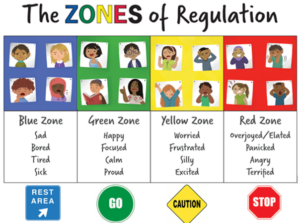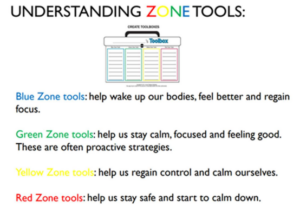
At Burwell Village College Primary School, we recognise the importance of promoting positive mental health and supporting the emotional wellbeing of our children and families. We aim to create an open culture around the discussion of mental health and wellbeing through the implementation of the Zones of Regulation curriculum. We teach our children to identify emotions in themselves, and others, and provide them with strategies to help regulate their emotions and improve their wellbeing.
Self-regulation can be described as the ability to adjust your level of alertness (including your senses, emotions and impulses) to fit the situation you are in and express this through socially appropriate behaviours.
The children learn different strategies to cope and manage their emotions based on the zone they are in. They are taught to be able to self-identify how they’re feeling and categorise it based on colour – blue, green, yellow and red.
What are the different zones?
Blue Zone: when your body is running slowly, such as when you are tired, sad, sick or bored.
Green Zone: when you are ready and good to go. You may be feeling happy, calm, feeling okay, focused.
Yellow Zone: when you begin to feel more intense emotions, such as when you are frustrated, overwhelmed, worried, silly/wiggly, excited, anxious or surprised.
Red Zone: when you have extreme feelings such as terror, uncontrolled anger, aggression or elation.
The children are taught that everyone experiences all of the zones at different points. It will be explained to them that the Red and Yellow zones are not necessarily ‘bad/negative’ zones and that we may experience all of them at one time or another.
Aims
As a school we aim to help the children:
- Increase their emotional vocabulary so they can explain how they are feeling.
- Recognise when they are in the different zones and identify a range of calming and alerting strategies that support them.
- Recognise when other people are in different zones, including reading facial expressions, to develop empathy.
- Develop problem-solving skills, resilience and understand how their actions can affect other people.
Understanding Zone Tools
You can use the resources below to support children with sensory devices and calming techniques to help them move between zones.

How will my child learn about the Zones of Regulation?
At Burwell Village College Primary School, we are using The Zones of Regulation as a whole school approach which allows us to develop a common language across the school in which to discuss emotions and behaviours.
All classrooms have the zones on display and the children can move their name or show a card to an adult to show how they are feeling. Depending on the zone they are in, and the child’s need, time will be given to help them regulate. This includes talking with an adult and using tools from the classroom. We want to help all children recognise when they are beginning to feel uncomfortable and have a toolbox of ideas to help them regulate themselves.
How can I help my child use The Zones of Regulation at home?
- Discuss together ways they can feel settled in the zone they identify in. Use yourself as an example. ‘I’m in the Yellow Zone and feeling worried, I could use some breathing techniques to help me feel calmer’.
- Create a list of strategies together. Remind them that everyone is different and the strategies do not have to be the same each time.
- Remind them that we will experience all zones and there are no ‘good’ or ‘bad’ zones. Being able to regulate our emotions depends on us recognising our emotion, understanding it and putting a support strategy in place.
- If they are unable to identify their emotion, try using a curious approach by asking, “I wonder if you are in the yellow zone at the moment, you seem a bit worried.’ This may then open up the discussion.
- Support them with identify their feeling, “You seem frustrated, am I right? I can understand why you may feel like this, would you like to talk about it or do you need some time to self-regulate?”
Other ways to help
- Identify your own feelings using zones language. For example, ‘I’m frustrated. I think I am in the Yellow Zone.’
- Modelling to show how you use tools to regulate. For example, ‘I’m going to make myself a cup of tea and sit down quietly, because I am in the Blue Zone’ and afterwards tell your child how using those tools helped you.
- Create your own family Zones of Regulation chart.
- Discuss which zone a character in a film / book might be in.
- Discuss the different zones and tools they can use when they are regulated / calm to ensure they are ready to listen and regulate.